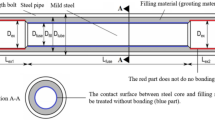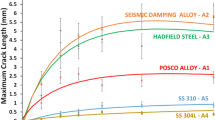Abstract
Ultra-high-strength steels are sensitive to heat input during welding, which can lead to softening in the heat-affected zone. This softening can also reduce the limit load capacity in non-load-carrying welds. One challenge is how to address this phenomenon in the design phase. To solve this problem, a method to determine material parameters for design and failure criteria is required. In this paper, a procedure using notched specimens to determine material parameters and failure criteria is presented. The results are compared with component-scale tests. The results show that the developed method results agree with results from the component tests. This procedure is a practical method to estimate the ultimate capacity of ultra-high-strength steels.































Similar content being viewed by others
References
Björk T, Toivonen J (2012) Capacity of fillet welded joints made of ultra high strength steel. Weld World 56:71–84
Bridgman WP (1944) The stress distribution at the neck of a tension specimen. Trans ASM 32:553–574
Dowling NE (2007) Mechanical behavior of material. Pearson Prentice Hall
Fonzo A, Mannucci G, Di Vito L F, Richard G (2008) Advanced tensile behaviour evaluation of girth welds. In: The proceedings of the eighteenth (2008) international offshore and polar engineering conferencE, ISOPE, vol 4. Cupertino, pp 57–63
Lemaitre J (1985) A continuous damage mechanics model for ductile fracture. J Eng Mater Technol 107:83–89
Liu PF, Zheng JY (2010) Finite element analysis of tensile behavior of ductile steel with defects. J Fail Anal Prev 10:212–217
Schaumann P, Keindorf C (2008) Hybrid towers for offshore wind energy converters. In: The proceedings of the eighteenth (2008) international offshore and polar engineering conference, ISOPE, vol 1. Cupertino, pp 431–440
Thomason PF (1990) Ductile fracture of metals. Pergamon Press
Tsuru E, Shinohara Y, Nagai K, Nagata Y, Hamatani H (2013) Reeling capability of non-heat-treated erw line pipes in r-lay. In: Proceedings of the twenty-third (2013) international offshore and polar engineering conference, ISOPE, vol 4. Cupertino, pp 560–566
Valkonen I (2013) Ultimate capacity of non-load-carrying welds of structural steel with yield strength 960 MPa. In: Proceedings of the twenty-third (2013) international offshore and polar engineering conference, ISOPE, vol 4. Cupertino, pp 93–100
Valkonen I, Kuoppala J (2011) Properties of non-load-carrying welds of structural steel with yield strength 960 MPa. In: Proceedings of the twenty-first (2011) international offshore and polar engineering conference, ISOPE, vol 4. Cupertino, pp 145–152
Zhang ZL, Ødegård J, Søvik OP (2001) Determining true stress-strain curve for isotropic and anisotropic materials with rectangular tensile bars: method and verifications. Comput Mater Sci 20:77–85
Zhang ZL, Hauge M, Thaulow J, Ødegård J (2002) A notched cross weld tensile testing method for determining true stress-strain curves for weldments. Eng Fract Mech 69:353–366
Acknowledgments
The support of the Ruukki Metals Oy and Finnish Metals and Engineering Competence Cluster (FIMECC) is gratefully acknowledged.
This paper was written as part of the Finnish Metals and Engineering Competence Cluster (FIMECC) Light program.
Author information
Authors and Affiliations
Corresponding author
Additional information
Doc. IIW-2478, recommended for publication by Commission XV “Design, Analysis and Fabrication of Welded Structures”
Rights and permissions
About this article
Cite this article
Valkonen, I. Estimation of limit load capacity of structural steel with yield strength 960 MPa. Weld World 58, 839–852 (2014). https://doi.org/10.1007/s40194-014-0163-6
Received:
Accepted:
Published:
Issue Date:
DOI: https://doi.org/10.1007/s40194-014-0163-6




